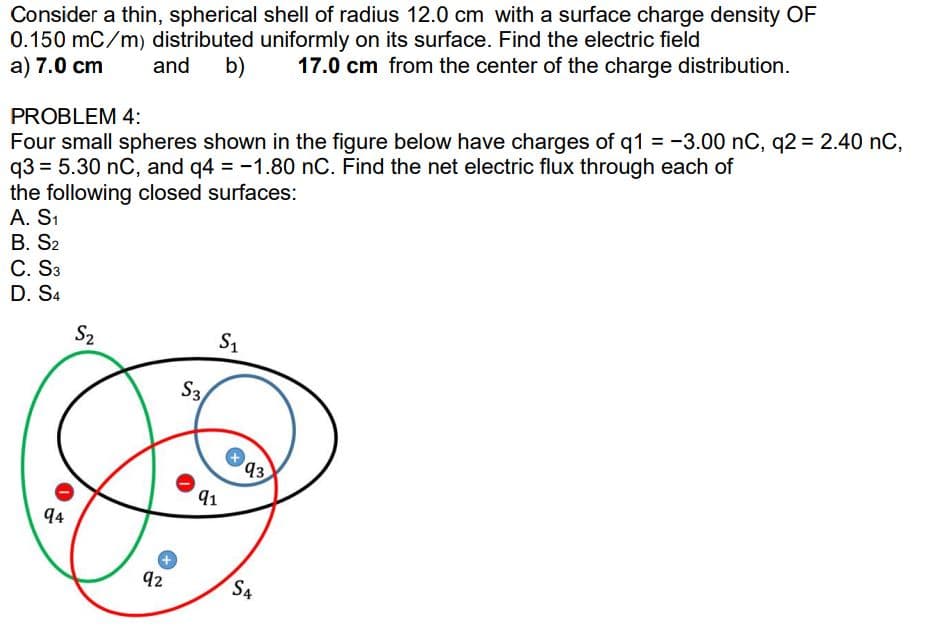Consider a thin, spherical shell of radius 12.0 cm with a surface charge density OF 0.150 mC/m) distributed uniformly on its surface. Find the electric field a) 7.0 cm and b) 17.0 cm from the center of the charge distribution. PROBLEM 4: Four small spheres shown in the figure below have charges of q1 = -3.00 nC, q2 = 2.40 nC, q3 = 5.30 nC, and q4 = -1.80 nC. Find the net electric flux through each of the following closed surfaces: A. S1 B. S2 C. S3 D. S4 S2 S1 S3 93 91 94 92 S4
Consider a thin, spherical shell of radius 12.0 cm with a surface charge density OF 0.150 mC/m) distributed uniformly on its surface. Find the electric field a) 7.0 cm and b) 17.0 cm from the center of the charge distribution. PROBLEM 4: Four small spheres shown in the figure below have charges of q1 = -3.00 nC, q2 = 2.40 nC, q3 = 5.30 nC, and q4 = -1.80 nC. Find the net electric flux through each of the following closed surfaces: A. S1 B. S2 C. S3 D. S4 S2 S1 S3 93 91 94 92 S4
Principles of Physics: A Calculus-Based Text
5th Edition
ISBN:9781133104261
Author:Raymond A. Serway, John W. Jewett
Publisher:Raymond A. Serway, John W. Jewett
Chapter19: Electric Forces And Electric Fields
Section: Chapter Questions
Problem 57P: A solid conducting sphere of radius 2.00 cm has a charge 8.00 μC. A conducting spherical shell of...
Related questions
Question

Transcribed Image Text:Consider a thin, spherical shell of radius 12.0 cm with a surface charge density OF
0.150 mC/m) distributed uniformly on its surface. Find the electric field
a) 7.0 cm
and
b)
17.0 cm from the center of the charge distribution.
PROBLEM 4:
Four small spheres shown in the figure below have charges of q1 = -3.00 nC, q2 = 2.40 nC,
q3 = 5.30 nC, and q4 = -1.80 nC. Find the net electric flux through each of
the following closed surfaces:
A. S1
B. S2
C. S3
D. S4
S2
S1
S3
93
91
94
92
S4
Expert Solution
This question has been solved!
Explore an expertly crafted, step-by-step solution for a thorough understanding of key concepts.
This is a popular solution!
Trending now
This is a popular solution!
Step by step
Solved in 2 steps with 10 images

Knowledge Booster
Learn more about
Need a deep-dive on the concept behind this application? Look no further. Learn more about this topic, physics and related others by exploring similar questions and additional content below.Recommended textbooks for you

Principles of Physics: A Calculus-Based Text
Physics
ISBN:
9781133104261
Author:
Raymond A. Serway, John W. Jewett
Publisher:
Cengage Learning

Physics for Scientists and Engineers: Foundations…
Physics
ISBN:
9781133939146
Author:
Katz, Debora M.
Publisher:
Cengage Learning


Principles of Physics: A Calculus-Based Text
Physics
ISBN:
9781133104261
Author:
Raymond A. Serway, John W. Jewett
Publisher:
Cengage Learning

Physics for Scientists and Engineers: Foundations…
Physics
ISBN:
9781133939146
Author:
Katz, Debora M.
Publisher:
Cengage Learning
